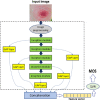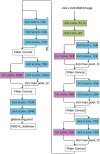Lyme rashes disease classification using deep feature fusion technique
- PMID: 38009027
- PMCID: PMC10628356
- DOI: 10.1111/srt.13519
Lyme rashes disease classification using deep feature fusion technique
Abstract
Automatic classification of Lyme disease rashes on the skin helps clinicians and dermatologists' probe and investigate Lyme skin rashes effectively. This paper proposes a new in-depth features fusion system to classify Lyme disease rashes. The proposed method consists of two main steps. First, three different deep learning models, Densenet201, InceptionV3, and Exception, were trained independently to extract the deep features from the erythema migrans (EM) images. Second, a deep feature fusion mechanism (meta classifier) is developed to integrate the deep features before the final classification output layer. The meta classifier is a basic deep convolutional neural network trained on original images and features extracted from base level three deep learning models. In the feature fusion mechanism, the last three layers of base models are dropped out and connected to the meta classifier. The proposed deep feature fusion method significantly improved the classification process, where the classification accuracy was 98.97%, which is particularly impressive than the other state-of-the-art models.
Keywords: Lyme disease; artificial intelligence; convolutional neural network classification; erythema migrans; fusion technique.
© 2023 The Authors. Skin Research and Technology published by John Wiley & Sons Ltd.
Conflict of interest statement
The authors have no conflict of interests.
Figures








Similar articles
-
Automated detection of erythema migrans and other confounding skin lesions via deep learning.Comput Biol Med. 2019 Feb;105:151-156. doi: 10.1016/j.compbiomed.2018.12.007. Epub 2018 Dec 18. Comput Biol Med. 2019. PMID: 30654165
-
Exploring convolutional neural networks with transfer learning for diagnosing Lyme disease from skin lesion images.Comput Methods Programs Biomed. 2022 Mar;215:106624. doi: 10.1016/j.cmpb.2022.106624. Epub 2022 Jan 10. Comput Methods Programs Biomed. 2022. PMID: 35051835
-
SkinNet-INIO: Multiclass Skin Lesion Localization and Classification Using Fusion-Assisted Deep Neural Networks and Improved Nature-Inspired Optimization Algorithm.Diagnostics (Basel). 2023 Sep 6;13(18):2869. doi: 10.3390/diagnostics13182869. Diagnostics (Basel). 2023. PMID: 37761236 Free PMC article.
-
Convolutional Neural Networks for ATC Classification.Curr Pharm Des. 2018;24(34):4007-4012. doi: 10.2174/1381612824666181112113438. Curr Pharm Des. 2018. PMID: 30417778 Review.
-
Unveiling the power of convolutional neural networks in melanoma diagnosis.Eur J Dermatol. 2023 Oct 1;33(5):495-505. doi: 10.1684/ejd.2023.4559. Eur J Dermatol. 2023. PMID: 38297925
Cited by
-
Bayesian-Edge system for classification and segmentation of skin lesions in Internet of Medical Things.Skin Res Technol. 2024 Aug;30(8):e13878. doi: 10.1111/srt.13878. Skin Res Technol. 2024. PMID: 39081158 Free PMC article.
-
Enhancing assisted diagnostic accuracy in scalp psoriasis: A Multi-Network Fusion Object Detection Framework for dermoscopic pattern diagnosis.Skin Res Technol. 2024 Apr;30(4):e13698. doi: 10.1111/srt.13698. Skin Res Technol. 2024. PMID: 38634154 Free PMC article.
-
Autism spectrum disorder detection using facial images: A performance comparison of pretrained convolutional neural networks.Healthc Technol Lett. 2024 Jan 8;11(4):227-239. doi: 10.1049/htl2.12073. eCollection 2024 Aug. Healthc Technol Lett. 2024. PMID: 39100502 Free PMC article.
-
Depression detection with machine learning of structural and non-structural dual languages.Healthc Technol Lett. 2024 Jun 10;11(4):218-226. doi: 10.1049/htl2.12088. eCollection 2024 Aug. Healthc Technol Lett. 2024. PMID: 39100503 Free PMC article.
-
Classification of Alzheimer disease using DenseNet-201 based on deep transfer learning technique.PLoS One. 2024 Sep 6;19(9):e0304995. doi: 10.1371/journal.pone.0304995. eCollection 2024. PLoS One. 2024. PMID: 39240975 Free PMC article.
References
-
- Importance of Skin Health All Year Round. 2021. [Online]: https://www.rosemedicalgroups.org/blog/importance‐of‐skin‐health‐all‐yea...#
-
- Voggu S, Rao KS. A survey on skin disease detection using deep learning techniques. J Algebr Stat. 2022;13(3):3916‐3920.
-
- Binol H, Plotner A, Sopkovich J, Kaffenberger B, Niazi MKK, Gurcan MN, Ros‐NET: a deep convolutional neural network for automatic identification of rosacea lesions. Skin Res Technol. 2020;26(3):413‐421. - PubMed
-
- Melenotte C, Drancourt M, Gorvel JP. Post‐bacterial infection chronic fatigue syndrome is not a latent infection. Med Maladies Infect. 2019;49(2):140‐149. - PubMed
MeSH terms
LinkOut - more resources
Full Text Sources
Medical

